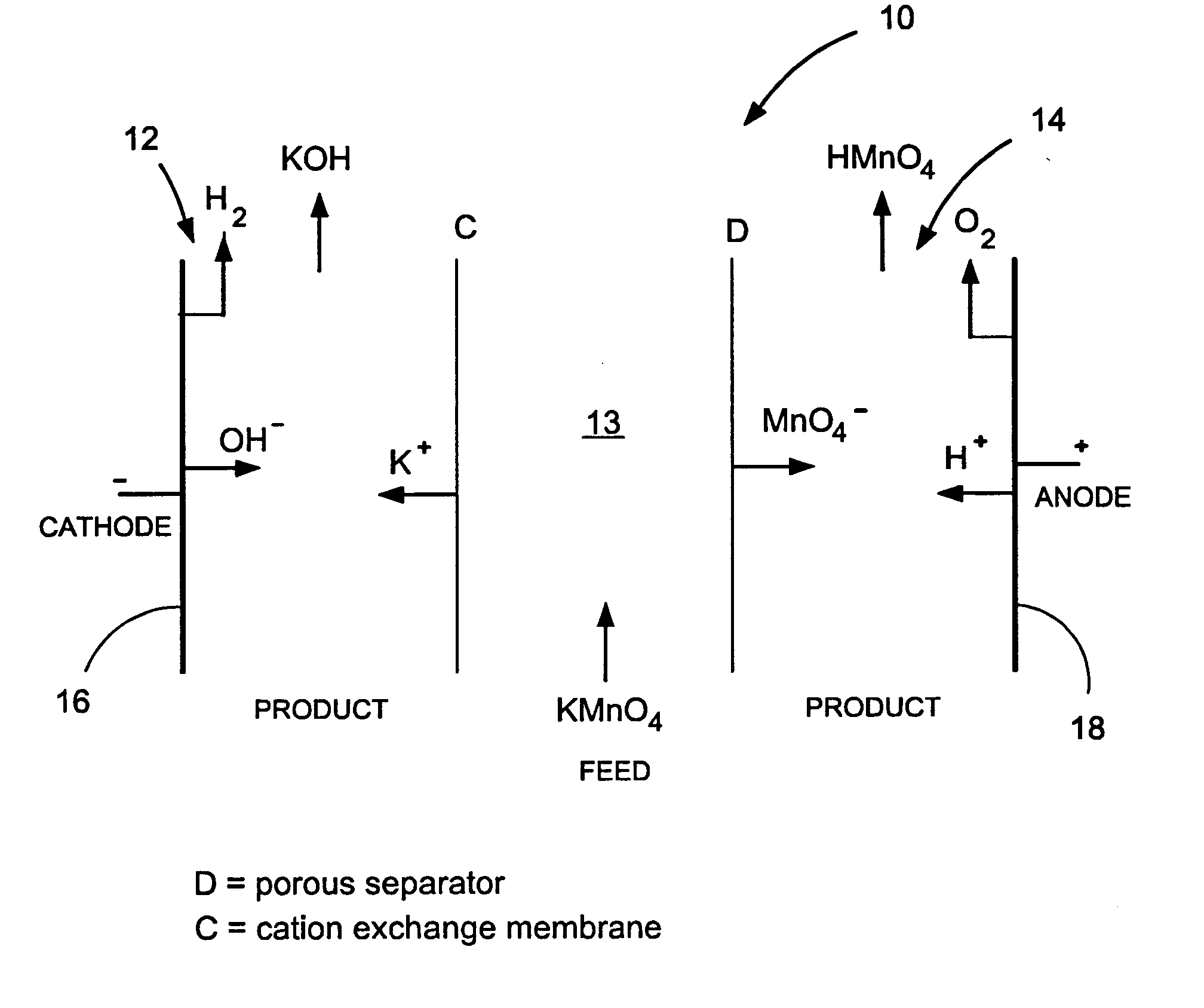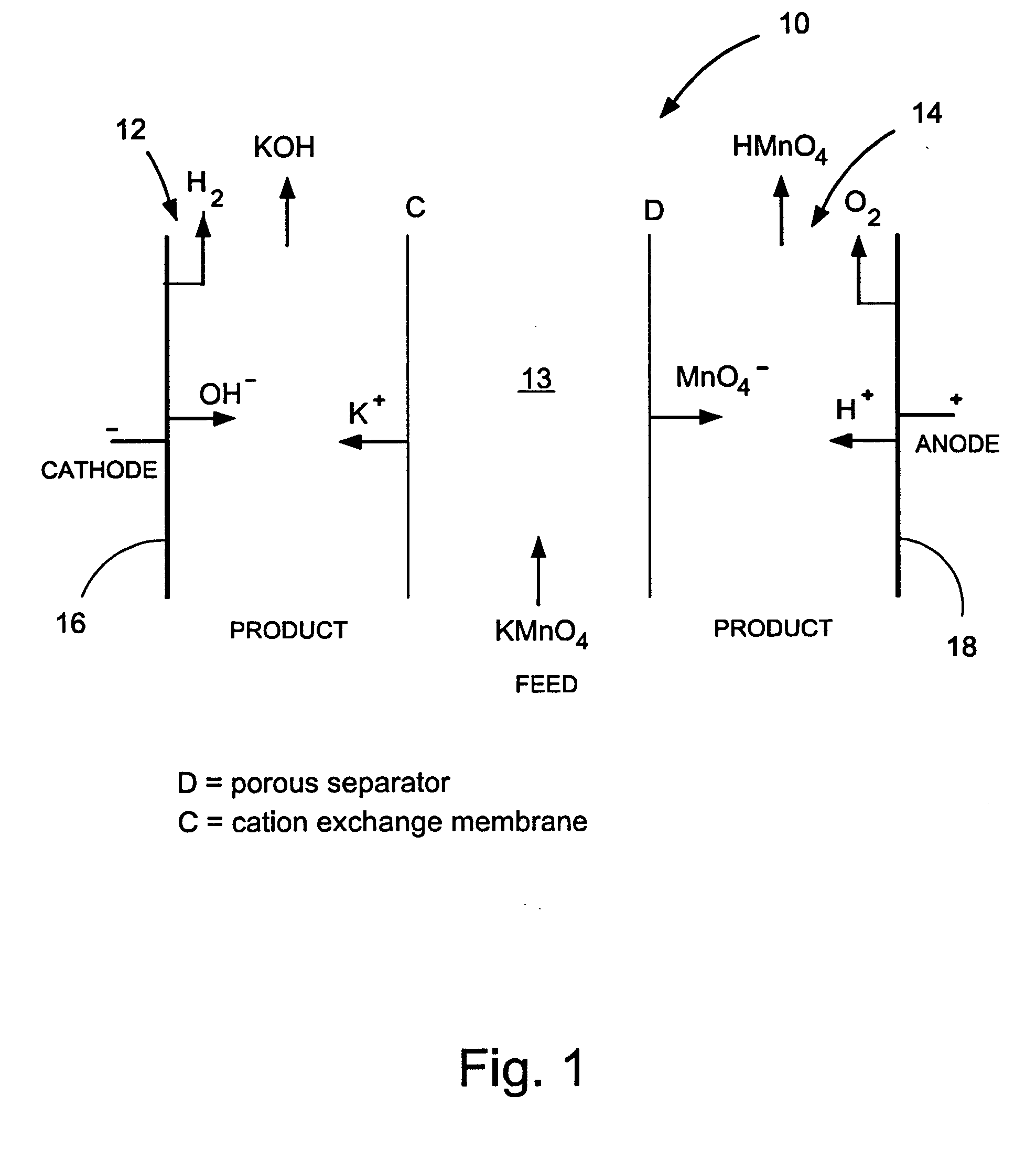Methods and apparatus for electrodialysis salt splitting
a technology of electrodialysis and salt, applied in the field of salt splitting, can solve the problems of large quantities of insoluble salt, inability to readily obtain non-potassium permanganate salts from native ores, and limited solubility of potassium permanganate,
- Summary
- Abstract
- Description
- Claims
- Application Information
AI Technical Summary
Benefits of technology
Problems solved by technology
Method used
Image
Examples
example 1
[0077] To demonstrate the metathesis electrodialysis salt splitting of potassium permanganate and magnesium acetate to provide magnesium permanganate and potassium acetate in a four-compartment electrodialysis cells the following experiment was conducted:
[0078] The following aqueous solutions were prepared: 1) magnesium acetate (800 grams of 35% by weight Mg(OAc)2.4H2O, 1.30 moles) as an initial feed; 2) potassium permanganate (1872 grams of 5% by weight KMnO4, 0.57 moles) as an initial feed; 3) magnesium permanganate (600 grams of 7.5% Mg(MnO4)2.5H2O, equivalent to 5.6% by weight Mg(MnO4)2, 0.128 moles) as an initial product; and 4) potassium acetate (1000 grams of 50% by weight KOAc, 5.09 moles) as an initial product. Initial solution pH values were then adjusted to 6.7 for potassium permanganate, 5.9 for magnesium permanganate, 7.3 for potassium acetate and 7.0 for magnesium acetate by addition of aqueous acid.
[0079] A metathesis electrodialysis set up was utilized comprised of...
example 2
[0083] To demonstrate the metathesis electrodialysis salt splitting of potassium permanganate and sodium phosphate to provide sodium permanganate and potassium phosphate in a four-compartment electrodialysis cell, the following experiment was conducted:
[0084] The following aqueous solutions were prepared: 1) sodium phosphate (641 grams of 10% by weight sodium phosphate, 0.39 moles) as an initial feed; 2) potassium permanganate (1832 grams of 5% by weight KMnO4, 0.55 moles) as an initial feed; 3) sodium permanganate (615 grams of 5% by weight NaMnO4, 0.22 moles) as an initial product; and 4) potassium phosphate (1077 grams of 10% K3PO4, 0.50 moles) as an initial product. Initial solution pH values were 8.77 for potassium permanganate, adjusted with sodium hydroxide to 12.8 for sodium permanganate, 12.49 for potassium phosphate and 12.35 for sodium phosphate. A metathesis electrodialysis set up was utilized comprised of an ElectroCell MP flow cell with 4 inlet / outlet connections sepa...
example 3
[0089] To demonstrate the metathesis electrodialysis salt splitting of sodium chlorate and magnesium acetate to provide magnesium chlorate and sodium acetate in a four-compartment electrodialysis cell, the following experiment is conducted:
[0090] The following aqueous solutions are prepared: 1) magnesium acetate (800 grams of 35% by weight Mg(OAc)2.4H2O, 1.30 moles) as an initial feed; 2) sodium chlorate (1000 grams of 10% by weight NaClO3, 0.94 moles) as an initial feed; 3) magnesium chlorate (500 grams of 10% Mg(ClO3)2, 0.26 moles) as an initial product; and 4) sodium acetate (1000 grams of 50% by weight NaOAc, 6.09 moles) as an initial product. A metathesis electrodialysis set up is utilized comprising of an ElectroCell MP flow cell with 4 inlet / outlet connections separately connected by means of PTFE and polypropylene piping and valves to 4 individual pumps and 4 individual PTFE tanks to allow continuous batch recirculation through the cell at flow rates up to 1 liters / minute. ...
PUM
| Property | Measurement | Unit |
|---|---|---|
| temperatures | aaaaa | aaaaa |
| operating temperatures | aaaaa | aaaaa |
| weight | aaaaa | aaaaa |
Abstract
Description
Claims
Application Information
 Login to View More
Login to View More - R&D
- Intellectual Property
- Life Sciences
- Materials
- Tech Scout
- Unparalleled Data Quality
- Higher Quality Content
- 60% Fewer Hallucinations
Browse by: Latest US Patents, China's latest patents, Technical Efficacy Thesaurus, Application Domain, Technology Topic, Popular Technical Reports.
© 2025 PatSnap. All rights reserved.Legal|Privacy policy|Modern Slavery Act Transparency Statement|Sitemap|About US| Contact US: help@patsnap.com



